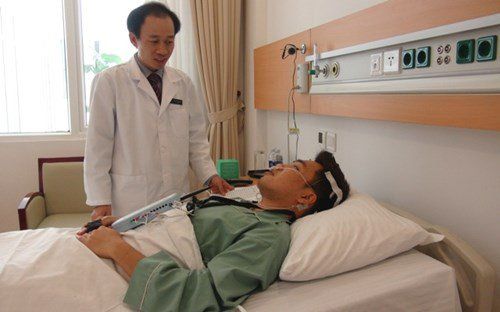This is an automatically translated article.
1) What is a brain stroke? A stroke is a disease that occurs when the blood supply to a part of the brain is suddenly stopped. In the past, a stroke is also known as a cerebrovascular accident. 2) Causes of cerebral stroke Stroke is usually caused by 2 main causes: a) A blocked brain vessel can be caused by a narrowing and occlusion of a blood vessel, or by a blood clot or a moving plaque. from another place to the cerebral artery and cause blockage b) Broken blood vessel due to sudden excessive blood pressure, rupture of brain aneurysm (brain blood vessel malformation bulges and ruptures) c) There are other causes Less common cause is: Transient ischemic attack similar to the above case, but the blood vessels are self-opening, so complete recovery within 24 hours. 3) What are the risk factors for stroke? High blood pressure, diabetes, atherosclerosis, high blood cholesterol, some heart diseases (valvular disease, atrial fibrillation...), smoking, alcoholism, blood clotting dysfunction, obesity , sedentary. 4) What are the symptoms of a stroke - Sudden weakness in arms and legs, numbness in the face, especially weakness, hemiparesis - Sudden blurred vision or loss of vision - Sudden difficulty speaking, slurred speech, or not understanding others say - Sudden severe headache with no known cause - Sudden dizziness (face darkening) stumbling, falling for no reason - In addition, sudden hiccups, nausea, vomiting without reason 5) What to do when a loved one has a stroke - Support the patient to prevent them from falling (because a patient's fall can cause traumatic brain injury after the stroke) - If the patient is still The province needs to let the patient lie quietly and call an ambulance to take the patient to the nearest specialized hospital - If the patient is comatose: it is necessary to see if the patient is still breathing normally, breathing fast, breathing slowly or stopping breathing because of an acute respiratory infection. Respiratory care is the first thing to do to ensure enough oxygen for the heart and brain. Therefore, artificial respiration is needed, if necessary, blow into the patient's mouth with the mouth if the patient stops breathing (note that the patient should lie on his back - one hand covers the patient's nose, one hand presses the chin to open the patient's mouth. and blow into the patient's mouth with your own mouth, if blowing correctly, the patient's chest expands according to the blowing rhythm. , acupuncture, wind blowing these movements can aggravate the condition unknowingly. Cerebral stroke can be in one of two forms: + Hemorrhagic stroke due to rupture of blood vessels + Cerebral infarction due to embolism - These two types cause cerebral stroke but are opposite in cause, mechanism and treatment due to stroke. It is necessary to have specialized doctors at the treatment facility with modern diagnostic tools to clearly determine the cause of the stroke for accurate treatment - Do not try to move the patient's head and neck (in case of stroke). falls or accidents) can cause secondary spinal cord injury. Put the patient in a comfortable position, loosen the clothes - Do not let the patient eat, drink and prevent vomiting causing reflux. Inhaling vomit or food into the airways will be very dangerous - Do not take Aspirin - Do not arbitrarily use antihypertensive drugs, only use antihypertensive drugs when BP > 180/100 mmHg (note that do not use small blood pressure lowering drugs under the tongue). 7) Management It is urgent to bring the patient to the hospital for proper diagnosis and treatment. For stroke patients "time is golden", embolism or rupture of blood vessels must be handled quickly to prevent complications, sequelae of hemiplegia, cerebral palsy, etc... Currently, hospitals The specialist has modern diagnostic tools for diagnosis, has a specialist doctor -> accurately diagnoses an occlusion or rupture of a vessel in order to have drugs to treat clots or can intervene to stop bleeding at the ruptured vessel. and patients recover quickly 8) Prevention - Well control risk factors: treat blood pressure, control blood sugar, blood lipids (blood cholesterol), quit smoking, fight obesity - Increase collective Exercise according to your health status, but choose exercises appropriately - do not over-exercise - Reduce stress (Reduce Stress), avoid sudden changes in posture, sudden changes from hot climates to hot climates. where the climate is cold or vice versa or there is a sudden change in pressure - People with high blood pressure should limit drinking beer etc ... take blood pressure medication as directed by the doctor - People People with artificial heart valves must take anticoagulants as prescribed by a specialist. Conclusion: A stroke is an emergency and often leaves sequelae such as paralysis, hemiplegia, so it is important to prevent and eliminate other factors. risk factors mentioned above. When having a brain stroke, it is not necessary to self-medicate, but it is necessary to quickly bring the patient to the hospital for timely diagnosis and treatment, with the right method.Prof. Dr. Do Tat Cuong, professional director of VINMEC International Hotel Hospital













